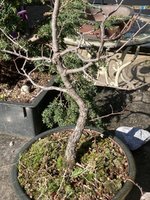rodeolthr
Shohin
Yes, I was just giving an example of what I do in my climate. When it gets down below freezing here, it can stay that way for 2 weeks and everything remains frozen solid. I'm originally from northern Wyoming, where at the time it was not uncommon to see temps of -40, so I definitely understand that there are varying degrees of cold and freezing.The OP is not in Washington state. They are in Washington DC/MD. I'm just south of them in No. Va. We have mild winters compared to Wisconsin, but harsh compared to Washington state. Lows can sometimes reach into sub-zero in bad winters. Normally nighttime lows are in the mid 20's in Jan. and Feb. They can go even lower for days on end. Duration of cold makes a big difference with overwintering, as well as only temperature. Exposure to prolonged deep freezes kills trees. Shohin and mame are usually the first to go.
A frozen pot is not a frozen pot. Depth of cold makes a huge difference. If that freeze is only into the mid-high 20's intracellular water generally doesn't freeze. Prolonged freezes below 25 F freezes intracellular water (water inside root tissue cells, as opposed to intercellular water between cells). That frozen intracellular water explodes living cells (like freezing a can of soda ruptures the aluminum as the content inside expand), damaging tissue or entire root systems.



